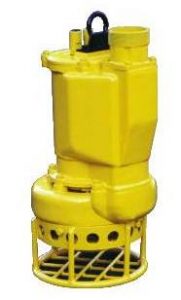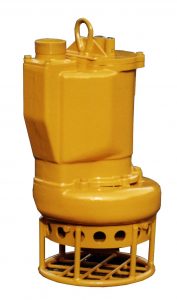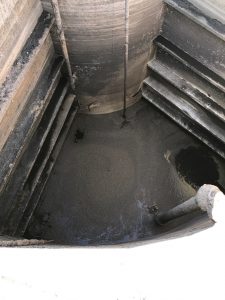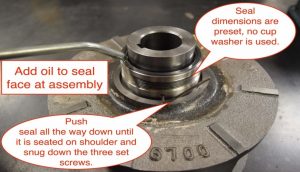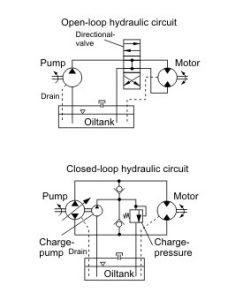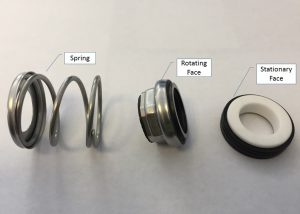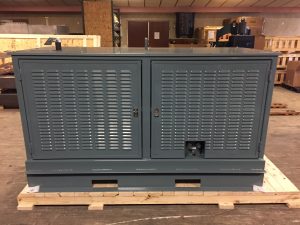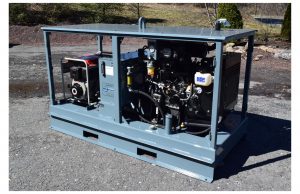As companies look for more efficient and effective ways to get fossil fuels out of the ground, the use of slurry pumps in cellars and for general mud handling at rig sites has become more common. Past practices included the use of trash pumps or close coupled centrifugal pumps to do this work, but those pumps were not designed specifically for the harsh duty of moving mud with specific gravities up to 2.4.
A few submersible pump companies developed and put to market their own versions of sand slurry pumps. These pumps featured some hardened wear components and in some cases external agitators to help homogenize the fluid being moved. These pumps vastly improved the work flow while at the same time offering better pump life. The start of a win-win.
We at Hydra-Tech decided to take this one step further and offer customers the opportunity to get up to 15% more head capacity and flow from the same size pump. To do this, we partnered with BJM pumps of Old Saybrook, CT and eliminated the limitation inherent in the typical electric motors which top out at around 1800 rpm. Specifically, we took BJM’s robust design and engineered a stronger shaft and bearing set along with all of the required adapters to mate to the lower end of the pump, including the hardened wear parts.
The result…performance curves that consistently and across the range of the curve provide more gallons per minute and a higher head capability. Additional benefits of using hydraulic power include the ability to slow down the impeller speed to meet specific pumping conditions and of course the added safety of not having high voltage electric cable running through water in an area where workers are present. This design is successful to the point where Hydra-Tec Pumps is now private labeling the units back to BJM with the hydraulic drive and this line of pumps is now widely used by the customers of both companies.
Beyond exploration, these pumps have also proven most effective in the Horizontal Directional Drilling industry as those firms transfer mud from the sump at the bore hole back to mud recycling systems.
This story is typical of what we have been doing at Hydra-Tech for the last 40 years; we work to find ways to create the best option for getting work done. That’s why the World Pumps us for Solutions.
This year’s WWETT Show in Indianapolis, Indiana was my 17th show in 18 years and I tell people all of the time that it is my favorite industry trade show. For 25 years or so WWETT was referred to simply as the Pumper Show (because that was really who it served) – in recent years it was renamed WWETT – for Water & Wastewater, Equipment, Treatment and Transport.
WWETT is the most laid back trade show I have ever attended. The casual atmosphere is due in large part to the number of family businesses that both attend and exhibit at the show, Hydra-Tech Pumps included. When I walked into the Pumper Show for the very first time in 1999 in a sport coat, I quickly realized that I was overdressed – overalls or jeans dominate the show floor at WWETT – you won’t see many suits and ties at this show. It is not unusual to see a group of 5-10 people from a small pumper company with a territory of a county or two come strolling down the aisle. Many times the group is an entire family and includes kids or grandkids who are enjoying a trade show for the first time (and especially those booths with the candy dishes!).
One of the companies that Hydra-Tech Pumps has had the pleasure of getting to know this year is AA Septic Service Inc. in Clayton, Indiana. James Penner’s father bought this business in 1984 from another family – more than 32 years later his family business still serves their community in central Indiana some 30 miles west of the Capital.
About 15 years ago James began exploring various septage dewatering equipment for their operation including a belt press, dewatering box, and vacuum pump systems – none of which worked to his satisfaction. At the time he was still able to cost effectively dispose of his septage. With the benefit of hindsight, James now says he should have pressed on because slowly but surely throughout the Pumper industry fewer and fewer municipal wastewater treatment plants were accepting septage. Also increased regulations restricting land application of septage, causing pumpers’ costs for disposal to significantly increase. James decided that the techniques he had tried weren’t working, so he addressed the problem in true American entrepreneurial fashion – he designed and built a complete dewatering system that would allow him to treat his septage.
After 4 years of developing, refining and testing his concept, he spun his idea off into In The Round Dewatering so that he could market and sell his solution to other pumpers around the country and around the world. James’ system is a patent pending dewatering drum that is fed from a storage tank and it processes a batch of sludge and polymer of up to 25,000 gallons.
James had one more challenge to overcome – how could he consistently, effectively and efficiently “feed” his dewatering beast when he needed to? He had access to a digester that was 16’ deep where he could store the septage, mix it into a homogenous fluid, and then pump it to his drum. The little trash pumps he used previously were inconsistent as the level of the water changed essentially affecting head. They also had issues with clogging and generally didn’t hold up for very long before needing replaced. After this year’s WWETT Show James reached out to us to figure out which pump would solve his problems for good. We hooked him up with an aluminum S3T Hydraulic Submersible Pump – James wrote to me a couple of months later to tell me about his experience since going hydraulic:
“The biggest challenge we have been experiencing during our several years of dewatering has been our ability to pump the liquid waste from the digester to the dewatering drum. From the beginning, we have used gas powered trash pumps as they are relatively inexpensive. We would scrap them when they quit and buy a new one. Finally, however, we decided to fix this issue by getting a three-inch submersible hydraulic pump from Hydra-Tech. The results have been amazing because all we do now is turn on the hydraulic flow and we are pumping. We no longer have issues priming or dealing with reduced flow when our tank levels get low. After using Hydra-Tech’s pump for several months, we have not experienced any plugging problems. The ability to increase the (hydraulic) oil flow and thereby have the pump speed up is more efficient because we are able to fill our In the Round Dewatering drum faster leading to fewer man-hours spent filling the drum. Dewatering has truly become much easier with the addition of this hydraulic submersible pump from Hydra-Tech. Additionally, the Hydra-Tech pump is light enough to transfer to other tanks making cleaning and emptying them easy. This pump has become a valuable asset to our operation.”
We hope to help more of James’ In The Round Dewatering drum customers efficiently get their wastewater from storage to drum more consistently, with better control, and with a light, reliable and long lasting pump. If you would like to learn more about James Penner’s serious dewatering drum, check out www.itrdewatering.com. Our thanks to James for his contributions to this story, as well as for his faith in our product – we are glad it did everything you hoped it would!
When choosing the right pump for the job there are always several things to consider. You have to make sure the pump can provide the right flow (GPM) at the total head the pump will have to overcome (TDH). You need to know if the pump is designed to handle solids or if it only needs to pump clear water. You may have an existing hydraulic power source you want to use to drive the pump so it is important that you find a pump that will match the available hydraulic supply. Other things to consider are the type of hydraulic and discharge hoses used for the job and hydraulic fitting selection.
Choosing the right materials of construction can make the job easier and extend the life of the pump. The majority of Hydra-Tech’s pumps are available in aluminum and ductile iron, some are available in stainless steel. Here are a few examples of the thought process behind choosing from different materials:
- Let’s say that the pump will need to handle some solid material from time to time but it is more important that it be lightweight so it can be hand carried to the center of a lagoon. In this case an aluminum body pump would be the best choice. An example of this could be the S4T-2.
- You have a settling tank that needs to be cleaned out on a regular basis and the fluids that get dumped into the tank have a wide range of PH values. To make sure the pump resists the corrosion that can occur in these conditions a stainless steel body, impeller and other parts would be the best way to go. An example could be the S3TSS pump.
- You have a mine dewatering application where the pump will be stationary and you know that there will be solid and semi solid materials (silt, sand, gravel, rocks) passing through and you will need a tough pump to take those hits. Ductile iron is good choice here – an S8T or S10T would move some water and be tough enough to withstand the solids passing through.
- The pump is being mounted on an oil skimmer and will be pumping primarily salty seawater and a mixture of various oils. A marine Aluminum Bronze construction would be a good choice for this application. Our S2TCAL-2 with optional Aluminum Bronze parts could be the answer.
What special consideration does your pump application require? Our technical specialists are here to help you make the informed choice.
Let’s answer the common question we get about seals…“Yes” part number 6715U replaces part numbers 6715 and 6716 on the channel impeller 6” pump head (S6TC). The drop in replacement requires no special machining, no special tools and no cup ring. This uniquely designed 21” manhole pump has been one of our most popular pumps for many years. As we continually try to improve things, we again listened to our customers when they described some of the field problems they experienced. While they understood that the extended oil housing in this pump head helps to keep the oil cool and extends the life of the mechanical seal, customers said it was prone to catching debris and causing seal failure. Our customers asked for a better design that would reduce failures caused by wire-ties, plastic bags, rags, branches and other things that get jammed in the seal area.
We responded by going back to the drawing board to make it better. With our own ideas on paper, we contacted our seal manufacturer to try and find a mechanical seal designed to hold up in one of the toughest of environments-the rental market! The result is the S6TC pump head’s new direct replacement seal, part number 6715U. This seal is also known as a bellows style seal because of its 316 stainless steel closed spring design (see the picture below of the #6715U seal installed).
To make things even better, we also redesigned the extended oil housing casting in new pumps being built today by adding four cast in place kick down lugs which push away the solids in the seal area. And we added a pin to prevent the stationary half of the mechanical seal from rotating. (NOTE: If you are only replacing the seal on a repair it is not necessary to add this pin).
To complete the upgrade, the seal faces are now made of silicone carbide to better hold up to the toughest mud, grit and fluids. The elastomers are made of Viton which resists a wide variety of chemicals and offers broad temperature operating ranges from 0° to 400° Fahrenheit.
The three set screws hold the rotating section in place on the impeller hub. Since the seal height is preset at the factory, the mechanical seal and will be at the correct height when you replace the impeller on the shaft.
As always, we appreciate your feedback on this and all of our products. With your continued support, Hydra-Tech Pumps will continue to make smart and cost effective improvements to our products, to benefit you.
http://conta.cc/2o9egaD
In a centrifugal pump, the mechanical seal (referred to as the “shaft seal assembly”) prevents the water that is being pumped from entering the bearing housing of the pump or simply the area between the motor face and the volute where the shaft passes through. This is not the same seal as the motor lip seal (or wiper seal), a part of the hydraulic motor that seals the motor shaft at the motor face and prevents any liquid from entering the hydraulic motor.
A picture is worth 1,000 words right?
You can see the different pieces of a mechanical seal, in the picture below – in this case a carbon ceramic seal that would be used in a number of our smaller pumps. It is called a mechanical seal because there are two halves of the seal with flat faces that are pressed together by a spring. A spring presses the primary ring (or rotating face) against the stationary face – the primary ring spins with the shaft and impeller, the seat or stationary face doesn’t move. Tiny amounts of liquid pass between but are typically vaporized by the heat of the shaft and seal before even getting past the mechanical seal – this liquid is actually important to the mechanical seal as it provides both cooling and lubrication.
The motor lip seal and the mechanical seal are the heart and soul of any submersible pump. In another piece we covered the causes of a motor lip seal failure – here we are going to cover the possible causes of a mechanical (or shaft) seal assembly failure. Some are simple and obvious, some might surprise you.
- Mechanical seals do wear out over time. Friction, heat and other factors contribute.
- Improper installation. If the mechanical seal is replaced and the new seal is not properly installed, this can lead to a quick failure of your new mechanical seal.
- Motor lip seal failure. If one of the many situations (see “What happened to my Motor Lip Seal” article 4/13/17) that can lead to a motor lip seal failure occurs, the bearing housing will fill with pressurized hydraulic fluid and push the stationary seat out of its recess (it will likely dislodge the rotating piece as well) and cause hydraulic fluid to flow into the volute.
- Debris in your pump. Something as simple as a plastic garbage bag or piece of rope can wrap around the pump shaft and compress the mechanical seal spring and jeopardize its function. Something like a long bolt with the strength to lock up the impeller can also have a detrimental effect on the mechanical seal.
We will follow up this post with one that covers some of the material choices available in mechanical seals and the pros & cons involved with those materials.
One of the things Hydra-Tech Pumps is known for is our customization – we have written about it before in general terms and have developed a long list of options for both pumps and power units from custom paint to custom design. How about an extreme example of something that started with an idea that we had never built before.
An excellent customer / distributor of ours who works in areas with extremely cold temperatures contacted us in November with an idea for a power unit that would be more appealing to his customers than our normal offerings. Oh, and it has to perform in subzero temperatures most of the time. And by the way Hydra-Tech hasn’t made this unit before. Can we do it? Our answer, as so often is the case, was “Yes, we can do that.”
The unit pictured below is a fully enclosed (although not sound attenuated) 35 horsepower liquid cooled diesel hydraulic power unit with a 54 gallon fuel tank and 30 gallon hydraulic oil reservoir. The unit will provide 14 GPM @ 4000 PSI to a submersible pump or any hydraulic tool and has both adjustable flow and adjustable pressure. For the extreme cold environment we included a 3.5kW Yanmar diesel generator that will power the engine block heater and hydraulic oil heater in the reservoir. It can also be used to power any electric tools required at the job site. The generator can be separated from the HPU by removing two pins and as a result can be used in a different area of the job site than the HPU. Complete access to the inside of the unit is available through the 6 louvered swing doors – 2 on each side and one on each end. To top it all off, every control on this Hydra-Tech HPU is properly labeled in the customer’s language.
This unit shipped about 4 months after the conversation about this HPU got serious enough to become an order. Have a custom hydraulic power unit design need that no one else will consider? Give us a call and let’s see if we can do it – I bet we can!
There are different types of hydraulic circuits used in fluid power applications.
The two types are described as Open Loop (or Open Circuit) and Closed Loop (or Closed Circuit).
Open Loop Circuits:
These are circuits where both the inlet to the hydraulic pump and the motor (or valve) return are connected to a hydraulic reservoir. The hydraulic flow from the pressure port on the pump is directed to the device that it is powering and then returned back to the reservoir. A relief valve or directional valve in the circuit may divert any unused fluid back to the reservoir. Suction strainers and return filters keep the fluid clean.
Advantages are:
- Generally less expensive.
- Better for lower pressure applications (below 3000 PSI).
- Simple to maintain and easier to diagnose problems if they occur.
Disadvantages are:
- Could create heat in the system if working pressure exceeds the relief valve setting when using fixed displacement pumps.
- Reservoir size has to be larger for adequate cooling of the fluid.
Closed Loop Circuits:
These are circuits where the motor return is connected directly to the hydraulic pump inlet. To maintain pressure in the loop, the circuits have a charge pump (a small gear pump) that supplies cooled and filtered oil to the low-pressure side. Closed-loop circuits are generally used for hydrostatic transmissions in mobile applications. The reservoir only has to have enough capacity to feed the small charge pump. These circuits are mainly used with higher-pressure piston hydraulic pumps and motors.
Advantages are:
- Systems can run at higher pressures with less fluid flow so smaller hydraulic lines can be used.
- Direction can be reversed without the use of valves.
- More control options are available.
Disadvantages are:
- More expensive components are used.
- May require high-pressure filtration.
- More difficult to diagnose and repair.
Many of the Hydra-Tech Pumps systems use open loop circuits with high efficiency pressure compensated hydraulic pumps to help prevent heat build-up while offering ease of maintenance that is so important in the field.
Examples of open and closed loop circuits.
In today’s world economy, it surprises us that many businesses large and small shy away from pursuing international sales opportunities. While the realities of language barriers, shipping regulations, import regulations, letters of credits and wire transfers can appear scary, doing business around the world need not be difficult or risky.
Like any transaction, the key to doing well internationally is to establish a level of trust between the companies involved. These days, most of the communication from foreign clients reach us by way of email. We do not treat these people or opportunities as secondary, rather we strive to answer their technical questions and make commercial offerings with the same accuracy and urgency as we provide to our domestic clients. This quick and clear transfer of information lets a potential buyer know that they are important and that you value their potential business. Because of email and language translate programs, written communication is most times much clearer and more effective than a verbal exchange. As the relationship grows over days, weeks or months, both parties will work through more technical issues, negotiate the commercial side of things and with good faith dealings on both sides put pen to paper on proper proposals and purchase orders.
That sounds easy, but what about the pitfalls associated with commercial transactions and logistics? On deals that are not in the millions of dollars, it is our experience that over 90% of foreign entities accept that a wire transfer between banks participating in the Swift program is both he most convenient and simplest way to complete transactions. The paperwork, fees and risks are minimal when compared to letters of credit or doing business on open terms. Of course as the relationship grows, moving a trusted oversees partner to open terms is something that we have done successfully in places like Russia, China, UK and Australia.
Probably the single biggest key on the logistics side is selecting a freight forwarder that has extensive experience moving product in to the destination country. This may mean different carriers for different areas of the world. Often times the customer desires to direct the freight, so providing them with accurate weights and dimensions (often in kilograms and centimeters) is required. A word of caution here…there are export restrictions placed by our government which forbid the sale or re-sale of goods to restricted countries and business entities. For information on this, it is best to review all federal trade regulations.
It should come as no surprise that the most difficult part of the process is the actual paperwork. Most countries place very exacting requirements on the importers of products; from requiring a license for every item code brought in to fumigated packing materials, to certain types of shrink wrap. While it may ultimately be up to the client to jump through these hoops, cooperation and patience on the seller’s part is required to further cement the relationship and to insure future business.
Because we take the steps outlined above, Hydra-Tech Pumps has been able to share our passion for providing pumping solutions to at least 20 countries around the world. Beyond the lands mentioned above, we placed pumps in Malaysia, Ireland, Denmark, Ukraine, Poland, Greece, Turkey and others. So regardless of the political climates around the world, there are many great business opportunities around this growing smaller planet.


